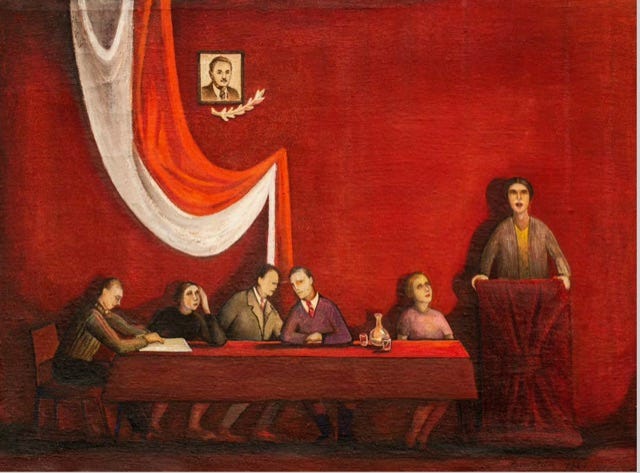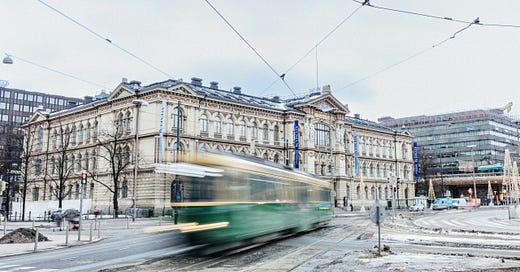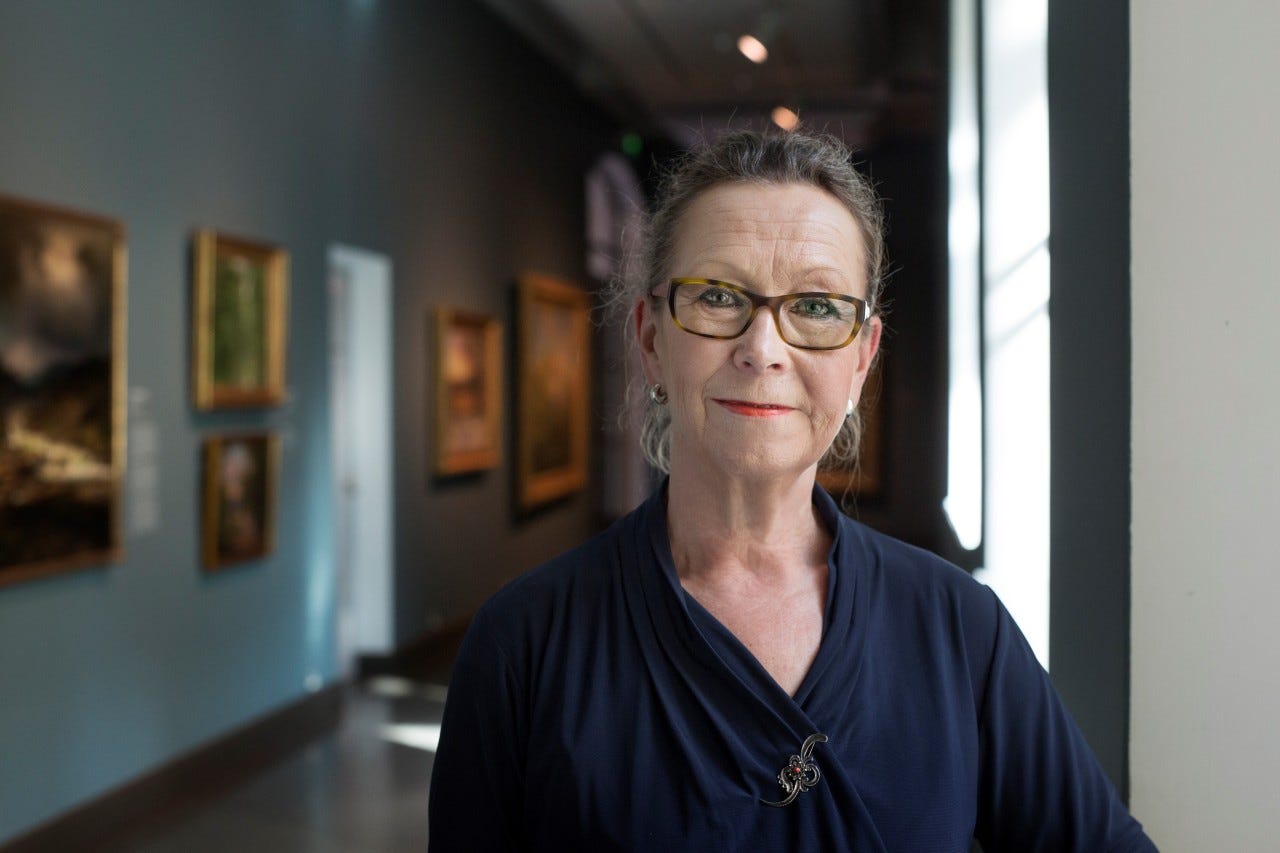Reopened and rehanged: Finland's premier gallery
INTERVIEW: Ateneum Art Museum Director Marja Sakari
“Fundamentally we wanted to answer the question – ‘How can Ateneum be a collection for everyone?’”
Also in this edition: the Hot List, and three articles you need to read.
— First time here? Subscribe to never miss an edition
The Big Interview
On Friday, Finland’s biggest and most famous art museum reopens to the public after a year-long closure. Located in the heart of Helsinki, the Ateneum Art Museum is part of the Finnish National Gallery and is renowned for its collection of Finnish and international art from the 19th century to the modern era, totalling over 30,000 artworks.
It closed in March 2022 for some rather unglamorous-sounding works: ventilation upgrades. But the museum has also used that time to carry out a full rehang of its permanent collection. The new collection exhibition is called A Question of Time and will include over 400 works by 200 artists. They’ll be old favourites, never-before-seen pieces, and rarely exhibited items.
To celebrate this exciting milestone for one of Europe’s premier galleries, this week’s interview is with Ateneum Director Marja Sakari. Marja has been at the helm of the museum since 2018, and was previously Chief Curator of exhibitions at the Museum of Contemporary Art Kiasma, another of the Finnish National Gallery sites.
We talked about why the ventilation revamp was actually vital for the museum’s work, the reasons behind the total rehang, and how she felt when she found out the museum was being gifted a very unexpected €1 million in someone’s will.
***
Hello Marja. The Ateneum Art Museum reopens this Friday! Tell us what's happened over the past 12 months?
A lot has happened, but the end result of the closure is in changes both to the physical fabric of our public spaces and in our way of looking at the collection.
The main reason for the renovation was renewing the whole ventilation system – it is a vital component of how we protect and conserve works of art for future generations and it is also one of the systems that became increasingly important during the pandemic. The new system consumes less energy and combined with solar panels we’ve had installed on the roof, it will help us to reduce costs and emissions.
What we hope visitors will notice is the difference in the experience they have moving through the museum. We took the opportunity to refurbish and remodel the atrium, entrance, clockroom and lobby areas, along with creating a new museum shop and toilets, to make all the spaces more accessible.
Other work included restoring the grand staircase and an upgrade to the technology in our auditorium. The renovations were untaken by Senaatti, a state-owned company which manages the properties owned by the Republic of Finland and cost around 17 million euros.
Visitors coming back to the museum will also see a complete rehang of the permanent collection. Why?
We’ve been thinking about the role of the collection for some time. In the years leading up to our 2020 exhibition Inspiration – Contemporary Art and Classics we actively thought about how the grand narratives of art history came about and what role museums have played in the process.
The 19th century was the golden age of the founding of museums in Europe, including the Ateneum which was founded in 1888. We actively sought to explore how our collection visually informed and impacted art history and Ateneum’s role in deciding who belonged in the canon.
The renovation work gave us the opportunity to refresh and renew the hang in the hopes of creating new perspectives and forging new connections with audiences. We’ll reopen with A Question of Time – a thematic exhibition compared to the usual chronological approach – where the aim is to provide a reflective space that ranges across different eras. Fundamentally we wanted to answer the question – ‘How can Ateneum be a collection for everyone?’
Tell me a bit about the process of carrying out a rehang - what work goes into it?
When we started to think about the rehang, we wanted to involve all our staff, the wider community and experts from outside the museum world. So, in 2021-22 we organised a series of discussions with SITRA, The Finnish Innovation Fund. We wanted to start conversations by inviting people from across all walks of life to help us in reimagining the museum's role in society. While visitors can still expect to find their beloved works, the exhibition will also highlight artworks presenting historically marginalised minorities and ethnic minorities such as the Roma and Sámi. Many of these works have received little attention because they have not been part of the prevailing narrative of Finnishness.
Finnishness and national identity are very big topics at the moment. The parliamentary elections have just been held and it seems that Finland's next government will shift to the right. This is one of the reasons why I think we need wider discussions about who Finns are and how is Finnishness portrayed.
What are some of the works that will be on show for the very first time?
When renovating a 130-year-old building, you have to be prepared for anything and during the renovation there were some fun discoveries of works in storage which have never been shown, including many from the post-war period.
The Ateneum is renowned for its collection of work from the turn of the 20th century, and many of the works from that period are all-time favourites of the Finnish public. In purely quantitative terms, however, the bulk of the collection contains more recent works and the Ateneum houses the largest collection of modernist art in Finland. Works from this period that visitors will now be able to enjoy include Erkki Heikkilä’s Floating Log Bundles (1970), Skipping Rope in Summer (1972) by Pirkko Lepistö and Kain Tapper’s, Heavy rain (1973).
But this is just the start of the process as the content of the exhibition will be updated over time so it will continually challenge the way in which the collection has traditionally been viewed.
What does the Ateneum’s collection say about Finland and Finnish society?
Whilst Finnish artists have always been inspired by international art movements, the collection can be seen as a reflection of Finnish society and its evolution over time. Many of the works in the collection were created during periods of significant cultural, social, and political change – including works by artists who were active during the period of Finnish national awakening in the late 19th century, when Finland was transitioning from being part of the Russian Empire to an independent nation. These works can be seen as expressions of Finnish identity and pride, as well as symbols of resistance against cultural assimilation and political oppression.
But the collection is not just about preserving the past – as mentioned one of the key questions we wanted to ask is with the rehang is What does being Finnish look like? In the 1800s, the Sámi, Russian Karelians, Roma and Jews were all considered outsiders. These divisions have created inequalities that can still be felt today – hence our decision to include works in the rehang that depict groups whose members were not part of the ruling class at the time – a new portrait of the nation.
Last year, you received an unprecedented legacy donation of over one million euros. How did you feel when you found out — and how are you spending the money?
After a tough few years, receiving this news was fantastic – we were elated. The money will be used to expand free admission to six free entrance days and two late nights a year and give free entry to students.
It has also enabled us to start a new community program to make the museum more inclusive and to reach groups who usually don’t visit museums. We’ve also been able to produce an audio guide to the collection display and to develop immersive elements to the interpretation to further engage audiences.
What would you say to any other citizens thinking about leaving the museum a legacy donation?
I realise that charitable giving is a very personal thing but absolutely, if people are moved to and are able to, I would like to see more legacy donations. Museums have the capacity to be transformative spaces and a legacy donation can have an enormous impact on our ability to expand accessibility, fund new education programs and exhibitions, and enhance our service to visitors and the wider community.
Is the museum still suffering from the effects of the Covid pandemic?
We were, and are, extremely lucky to have the support of the Finnish state. That helped us to recover more quickly as an institution and continue our activities as planned. What’s been challenging is trying to maintain the sense of community we have with the public as the closure for the renovations came quite soon after the liftings of all the covid restrictions.
When people come to visit Helsinki they should obviously visit the Ateneum Museum. But what else should be on their itinerary?
Yes, people should definitely visit Ateneum and our sister museums, Kiasma and the Sinebrychoff. But there are so many more including Amos Rex, the HAM (Helsinki Art Museum) and the EMMA (Espoo Museum of Modern Art). Helsinki is a very walkable city so depending how much time you have you can cover a lot of ground. Helsinki Design District is a hub of creativity, featuring shops, studios, and galleries showcasing Finnish design, fashion and architecture. I would recommend checking out the Oodi Library for its striking design and innovative and modern approach, and if architecture is an interest, the Alvar Aalto home in Munkkiniemi is a must!
The Ateneum Art Museum reopens on Friday
The Hot List
maxwell museums’ curated round up of what’s new to see, do, watch, read and more
EXHIBITION
🔗 I saw the other side of the sun with you: Female Surrealists from Eastern Europe
Cromwell Place, London
Presenting some of the most outstanding female Surrealists from Poland, former Czechoslovakia, and former Yugoslavia, (most of whom are still largely unknown in the West), this is the world’s first exhibition dedicated exclusively to female Surrealists from Eastern Europe, and has been commissioned by the European ArtEast Foundation. Until 30 April

FILM
🔗 Vermeer: The Greatest Exhibition
Across the UK
If you don’t have tickets to the Rijksmuseum’s Vermeer blockbuster, this new cinematic viewing is likely the only way you’re going to see it. This new Exhibition on Screen film invites audiences to a private view of the show, accompanied by the museum’s director and the curator. Released 18 April, with encore screenings
EXHIBITION
🔗 Style & Society: Dressing the Georgians
The Queen's Gallery, Buckingham Palace
Explore what the Georgians wore, from the practical dress of laundry maids to the glittering gowns worn at court. Delve into the Georgians’ style story and get up close to magnificent paintings, prints and drawings by artists including Gainsborough, Zoffany and Hogarth. Opens 21 April
BOOK
🔗 All the Beauty in the World: A Museum Guard’s Adventures in Life, Loss and Art
Patrick Bringley
When Patrick Bringley’s brother was diagnosed with terminal cancer, he quit his journalism job, and sought peace in the most beautiful place he knew. This revelatory portrait of life guarding the galleries of the Met Museum in New York has been described as “uplifting” and “hauntingly beautiful.” Published by Bodley Head
Three to Read
1 | A new exhibition is revealing one of the few stories left to tell about Andy Warhol: his work with textiles. The FT examines the hunt for these rare designs. (Read)
2 | Three of Britain’s biggest artists have unveiled their bricks and mortar legacies. The Sunday Times celebrates Gilbert and George and Tracey Emin’s new ‘monuments’. (Read)
3 | Leeds is holding a year-long celebration of culture, after Brexit derailed its bid to be European Capital of Culture. Here’s 10 hidden gems to see if you’re visiting. (Read)
— Get the next edition in your inbox. Subscribe here





